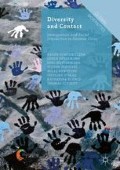Abstract
This chapter explains the design of the Diversity and Contact study and the methods used. We explain how the 50 neighbourhoods were selected and provide details about the panel survey, the area explorations and the field studies in five selected neighbourhoods.
Access this chapter
Tax calculation will be finalised at checkout
Purchases are for personal use only
Notes
- 1.
The European Social Survey, for instance, contains only subjective information about the ethnic composition of the neighbourhoods in which respondents reside. Data of the bi-annual German ALLBUS contain information on the type of context (Gemeindegrößenklassen).
- 2.
Since 1987, annual micro censuses have been conducted that encompass one per cent of households. Due to this limited scope, the data do not provide information for the neighbourhood level. In 2011, a 10 per cent census was conducted, but the data were not available in time for this study and do not allow representative analyses at the neighbourhood level. The GSOEP offers data that can be broken down to the relatively large postal districts (see Drever 2008). These areas are not identical with statistical areas.
- 3.
The federal and state statistical offices now make data on ‘migration background’, that is first and second generation immigrants, available but not throughout for smaller cities and generally not on the neighbourhood level. Larger cities sometimes provide their own statistics, occasionally also for districts within the city, but this is not done in a uniform way, and the number of cities providing such data is as yet not large enough.
- 4.
We asked ‘Do you consider yourself part of an ethnic or religious minority?’ Only 129 (5 per cent) respondents said that they belonged to a minority group. Only a dozen saw themselves as belonging to an ethnic minority; most of the responses referred to a religious minority which often meant a Catholic or Protestant minority background.
- 5.
This was defined as share of the unemployed of all inhabitants aged 15–64. This was the only measure available on the small area-level, unfortunately it is different from the one used by the German state and from the ILO definition.
- 6.
For an analysis of panel attrition, see Annex.
- 7.
In wave two, incentives were offered to respondents who either had not been reached by telephone or earlier in the field phase refused to be interviewed because of lack of time. In wave three we used incentives for respondents with a migration background, for respondents aged 40 or younger and for respondents who had received an incentive in wave two.
- 8.
The sample census covers 1 per cent of the total population in Germany (roughly 800,000 individuals). Participation is obligatory. It is carried out by the Statistische Landesämter and the Statistisches Bundesamt (Federal Statistical Office).
- 9.
Answers to questions referring to foreign birth, nationality, ethnicity, reflect the saliency of borders; we will learn about intergroup interactions the respondents are conscious of. In all likelihood, we—like other analyses based on common surveys—underestimate existing intergroup interactions.
- 10.
We use that term in some questions testing attitudes because these questions aim to reflect common perceptions.
- 11.
We developed our own methodology because we are not interested in the same issues (crime/disorder versus diversity) and devices like counting syringes on the pavement would not have made much sense in our neighbourhoods as you rarely find them. For a description of the methodology used for the Chicago project see Raudenbusch and Sampson 1999.
- 12.
Apart from the authors of this book, this included Christian Jacobs, Diana Aurisch, Friedrich Striewski, Thorsten Walbott.
- 13.
These features were established based on aerial maps and Internet research.
- 14.
Obviously, this captures only the more visible parts of the immigrant population or those whose appearance we linked with a likelihood of immigrant background. We accept these restrictions because we assume that the population will also notice immigration in such a limited and distorted way.
- 15.
Robert Sampson (2012: 164) refers to the share of those resident for less than five years as measure of neighbourhood stability.
- 16.
The share of those who had lived in the neighbourhood for no more than five years ranges from 6 to 57 per cent.
- 17.
The survey question was: ‘Why did you choose to move to [INT.: emphasize] this particular neighbourhood back then? Please only name the most important or the two most important reasons.’
- 18.
We also excluded respondents who were five years or younger when they moved to the neighbourhood.
- 19.
Characteristics of respondents and their households—such as age, gender, education, occupational status, household size, and household income—are practically irrelevant for whether aspects of the social conditions or the atmosphere of the neighbourhood were mentioned as main reasons for moving or not.
- 20.
We asked: ‘All in all, how comfortable do you feel in your neighbourhood?’
Author information
Authors and Affiliations
Copyright information
© 2016 The Author(s)
About this chapter
Cite this chapter
Schönwälder, K. et al. (2016). The Diversity and Contact Project (DivCon). In: Diversity and Contact. Global Diversities. Palgrave Macmillan, London. https://doi.org/10.1057/978-1-137-58603-2_2
Download citation
DOI: https://doi.org/10.1057/978-1-137-58603-2_2
Published:
Publisher Name: Palgrave Macmillan, London
Print ISBN: 978-1-137-58602-5
Online ISBN: 978-1-137-58603-2
eBook Packages: Social SciencesSocial Sciences (R0)

